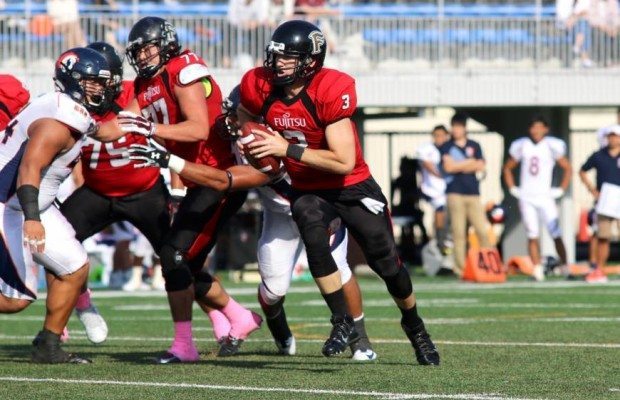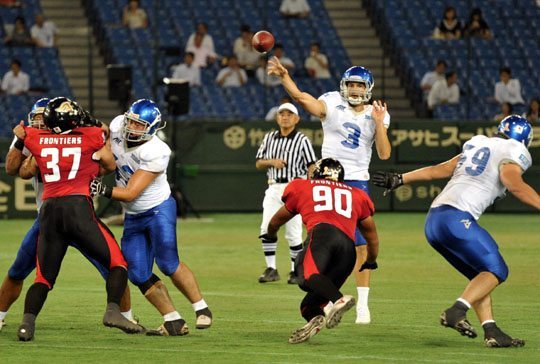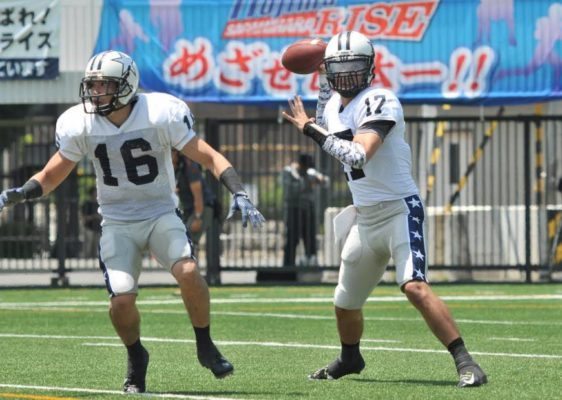Foreign Quarterbacks Raising Standards in Japan’s X League

Frontiers quarterback Colby Cameron runs against the Rise during a game in Kawasaki last month. The American led Fujitsu to the X League title last year
In Japanese football’s eight decades of history, the last few years have clearly been an epoch-making period because of one trend: an influx of American quarterbacks.
Since the IBM BigBlue became the first team to have an American — Kevin Craft — at the position in 2012, the league has added one after another every year. A couple of clubs followed the trend this year, and a total of five American quarterbacks are currently playing for Japanese teams.
Craft had a big impact in his first year in Japan. With the ex-UCLA player under center, the BigBlue turned into a prolific offensive team. They averaged 367.7 total yards (184.4 passing) in the 2011 fall season, and improved to 469.7 yards (279.9) with Craft the following year.
“That’s good,” said former Louisiana Tech University player Colby Cameron, who guided the Fujitsu Frontiers to their first X League championship last year. “It makes the league more competitive. A lot of American quarterbacks have strong arms and really spread the field. It’s fun to compete against them.”
Last fall season, Craft and Cameron were locked in an unprecedented passing race. Craft led the X League with 1,927 yards passing, followed by Cameron, who had 1,822 yards. Both threw a league-high 22 touchdowns. Craft’s BigBlue and Cameron’s Frontiers squared off in the Japan X Bowl, the league championship game, last December.
Craft said he knew other clubs would follow IBM in acquiring American quarterbacks, because that was the case in Europe, where he had previously played. According to Craft, who played in France, many European teams had American quarterbacks.
Case in point: Craft cited Asahi Beer Silver Star newcomer Mason Mills, who has provided extra power, as an example.
“Mason, he’s made a big impact on his team already,” Craft said after his IBM defeated the Silver Star in Kawasaki in early October. “They did things they weren’t doing in the last couple of years. Yeah, they are changing, and I think a lot of teams are changing. The style of play, the offense, and the way defense has to play against their offense.”
Mills is leading the 18-team X League first division with 1,957 yards (21 TDs) so far this season.
Like Craft did for the BigBlue, Mills has upgraded the Silver Star offense enormously. The former University of San Diego signal-caller has improved the Silver Star offense by about 200 yards per game in the first five games of this fall season both in its total yards (293.0 to 486.8) and passing yards (213.9 to 418.8) compared with their previous fall campaign.
The Silver Star landed wideout Roman Wilson along with Mills, and that’s been a plus as well.
Silver Star offensive coordinator Hayato Arima said that with Mills’ stronger arm and wider vision, the team is able to utilize a broader range of the field and has more options offensively.
“Because we use a wider area of the field, every (opposing) defender has to cover a bigger area,” Arima said. “And that’s why we’ve completed our passes more.”
Craft agrees and finds himself enjoying playing with talented Japanese players around him.
“I think in Japan, they have really skilled guys,” Craft said. “The skill positions are pretty good and they really play at a higher level, smart, quick . . . They could get physical, and more so than like in Europe and stuff. So you can do a lot of things throwing the ball, utilizing some of the talent Japan has.
“The national team, they’ve got guys that played in NFL Europe. Guys that were in the Ravens camp (IBM wide receiver Takashi Kurihara) and Falcons camp (Obic Seagulls wideout Noriaki Kinoshita).”
Mills said:
“You have the NFL and the CFL. But I think Japanese level is the next-best league after the United States and Canada. So I think it’s very competitive.”
Arima said that American quarterbacks develop defenses as well as offenses, because the defenders with American quarterbacks on their teams encounter them in practice.
Shinzo Yamada, the IBM head coach, believes it was a natural conclusion for he and his club to allocate one of the four spots for foreign players (up to two can take the field simultaneously) to a quarterback.
“I didn’t understand why nobody would get a quarterback,” said Yamada, a former linebacker in NFL Europa and the XFL (both of which are now defunct).
“I’d been the head coach for two years (before Craft came in), and thought that maybe we wouldn’t be able to win the championship with the status quo. Then we made up our mind to get a quarterback. Luckily, it’s really paid off for us to have Craft.”
But even for the Americans, who have an edge physically and have played the position longer than Japanese quarterbacks in general (many of the Japanese players begin playing football in high school or college), it isn’t necessarily easy to adjust to their new surroundings because of the different playing styles and the language barrier.
After all, no matter where you are from and no matter which country you play in, it takes time to get in sync with your team in football, where communication and preparation matter a great deal.
“I think that, as I’ve had a lot of time to work with our guys, they know what I’m thinking and they know how I can throw it,” Craft said. “So we’re all on the same page a lot with our own guys.
“I’ve had some time to play against the Japanese style of defense, which is a little bit different than the way they play it in America.”
Meanwhile, the employment of American QBs in Japan is also creating friction. The opposing faction thinks the Americans take spots from Japanese players and won’t help develop football in Japan.
Arima admits it is a difficult issue, but believes it could help raise the bar for Japanese football overall in the long run.
“It may take some time, but if you ask Japanese quarterbacks about the standard that the Americans are playing at, eventually you are going to have Japanese quarterbacks that are as good,” he said. “I’d like to see that happen, and I believe it’s a good thing.”
Read the original article here.
Published in the Japan Times November 2, 2015.
Reposted with permission.

